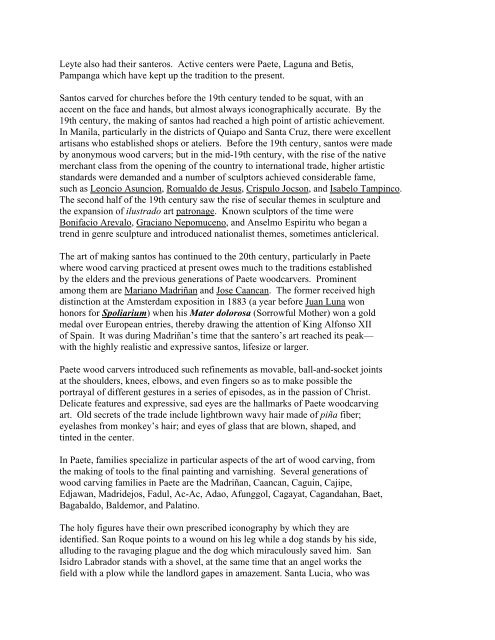SCULPTURE Sculpture is the art of making three-dimensional ...
SCULPTURE Sculpture is the art of making three-dimensional ...
SCULPTURE Sculpture is the art of making three-dimensional ...
Create successful ePaper yourself
Turn your PDF publications into a flip-book with our unique Google optimized e-Paper software.
Leyte also had <strong>the</strong>ir santeros. Active centers were Paete, Laguna and Bet<strong>is</strong>,<br />
Pampanga which have kept up <strong>the</strong> tradition to <strong>the</strong> present.<br />
Santos carved for churches before <strong>the</strong> 19th century tended to be squat, with an<br />
accent on <strong>the</strong> face and hands, but almost always iconographically accurate. By <strong>the</strong><br />
19th century, <strong>the</strong> <strong>making</strong> <strong>of</strong> santos had reached a high point <strong>of</strong> <strong>art</strong><strong>is</strong>tic achievement.<br />
In Manila, p<strong>art</strong>icularly in <strong>the</strong> d<strong>is</strong>tricts <strong>of</strong> Quiapo and Santa Cruz, <strong>the</strong>re were excellent<br />
<strong>art</strong><strong>is</strong>ans who establ<strong>is</strong>hed shops or ateliers. Before <strong>the</strong> 19th century, santos were made<br />
by anonymous wood carvers; but in <strong>the</strong> mid-19th century, with <strong>the</strong> r<strong>is</strong>e <strong>of</strong> <strong>the</strong> native<br />
merchant class from <strong>the</strong> opening <strong>of</strong> <strong>the</strong> country to international trade, higher <strong>art</strong><strong>is</strong>tic<br />
standards were demanded and a number <strong>of</strong> sculptors achieved considerable fame,<br />
such as Leoncio Asuncion, Romualdo de Jesus, Cr<strong>is</strong>pulo Jocson, and Isabelo Tampinco.<br />
The second half <strong>of</strong> <strong>the</strong> 19th century saw <strong>the</strong> r<strong>is</strong>e <strong>of</strong> secular <strong>the</strong>mes in sculpture and<br />
<strong>the</strong> expansion <strong>of</strong> ilustrado <strong>art</strong> patronage. Known sculptors <strong>of</strong> <strong>the</strong> time were<br />
Bonifacio Arevalo, Graciano Nepomuceno, and Anselmo Espiritu who began a<br />
trend in genre sculpture and introduced national<strong>is</strong>t <strong>the</strong>mes, sometimes anticlerical.<br />
The <strong>art</strong> <strong>of</strong> <strong>making</strong> santos has continued to <strong>the</strong> 20th century, p<strong>art</strong>icularly in Paete<br />
where wood carving practiced at present owes much to <strong>the</strong> traditions establ<strong>is</strong>hed<br />
by <strong>the</strong> elders and <strong>the</strong> previous generations <strong>of</strong> Paete woodcarvers. Prominent<br />
among <strong>the</strong>m are Mariano Madriñan and Jose Caancan. The former received high<br />
d<strong>is</strong>tinction at <strong>the</strong> Amsterdam exposition in 1883 (a year before Juan Luna won<br />
honors for Spoliarium) when h<strong>is</strong> Mater dolorosa (Sorrowful Mo<strong>the</strong>r) won a gold<br />
medal over European entries, <strong>the</strong>reby drawing <strong>the</strong> attention <strong>of</strong> King Alfonso XII<br />
<strong>of</strong> Spain. It was during Madriñan’s time that <strong>the</strong> santero’s <strong>art</strong> reached its peak—<br />
with <strong>the</strong> highly real<strong>is</strong>tic and expressive santos, lifesize or larger.<br />
Paete wood carvers introduced such refinements as movable, ball-and-socket joints<br />
at <strong>the</strong> shoulders, knees, elbows, and even fingers so as to make possible <strong>the</strong><br />
portrayal <strong>of</strong> different gestures in a series <strong>of</strong> ep<strong>is</strong>odes, as in <strong>the</strong> passion <strong>of</strong> Chr<strong>is</strong>t.<br />
Delicate features and expressive, sad eyes are <strong>the</strong> hallmarks <strong>of</strong> Paete woodcarving<br />
<strong>art</strong>. Old secrets <strong>of</strong> <strong>the</strong> trade include lightbrown wavy hair made <strong>of</strong> piña fiber;<br />
eyelashes from monkey’s hair; and eyes <strong>of</strong> glass that are blown, shaped, and<br />
tinted in <strong>the</strong> center.<br />
In Paete, families specialize in p<strong>art</strong>icular aspects <strong>of</strong> <strong>the</strong> <strong>art</strong> <strong>of</strong> wood carving, from<br />
<strong>the</strong> <strong>making</strong> <strong>of</strong> tools to <strong>the</strong> final painting and varn<strong>is</strong>hing. Several generations <strong>of</strong><br />
wood carving families in Paete are <strong>the</strong> Madriñan, Caancan, Caguin, Cajipe,<br />
Edjawan, Madridejos, Fadul, Ac-Ac, Adao, Afunggol, Cagayat, Cagandahan, Baet,<br />
Bagabaldo, Baldemor, and Palatino.<br />
The holy figures have <strong>the</strong>ir own prescribed iconography by which <strong>the</strong>y are<br />
identified. San Roque points to a wound on h<strong>is</strong> leg while a dog stands by h<strong>is</strong> side,<br />
alluding to <strong>the</strong> ravaging plague and <strong>the</strong> dog which miraculously saved him. San<br />
Isidro Labrador stands with a shovel, at <strong>the</strong> same time that an angel works <strong>the</strong><br />
field with a plow while <strong>the</strong> landlord gapes in amazement. Santa Lucia, who was

















